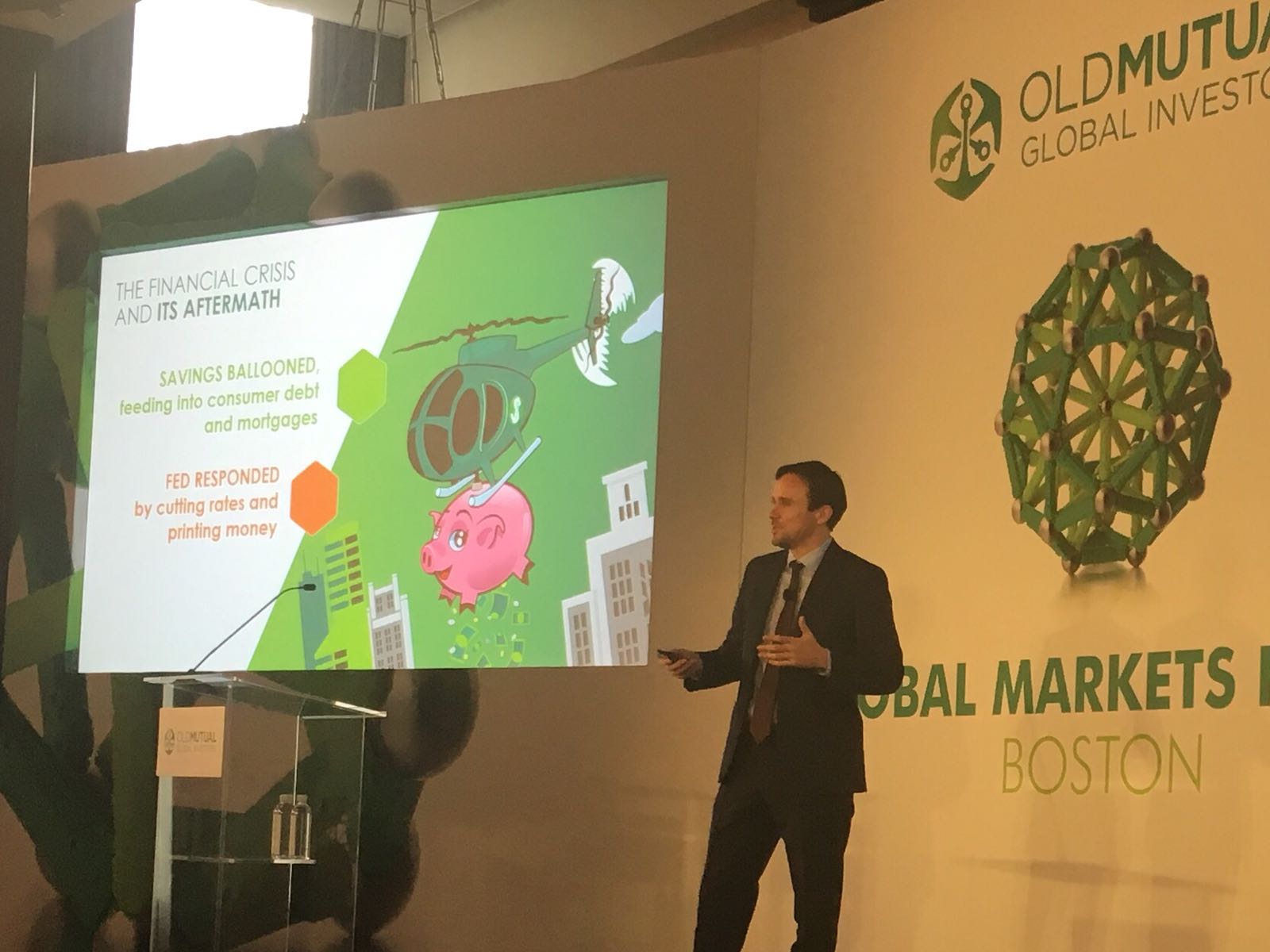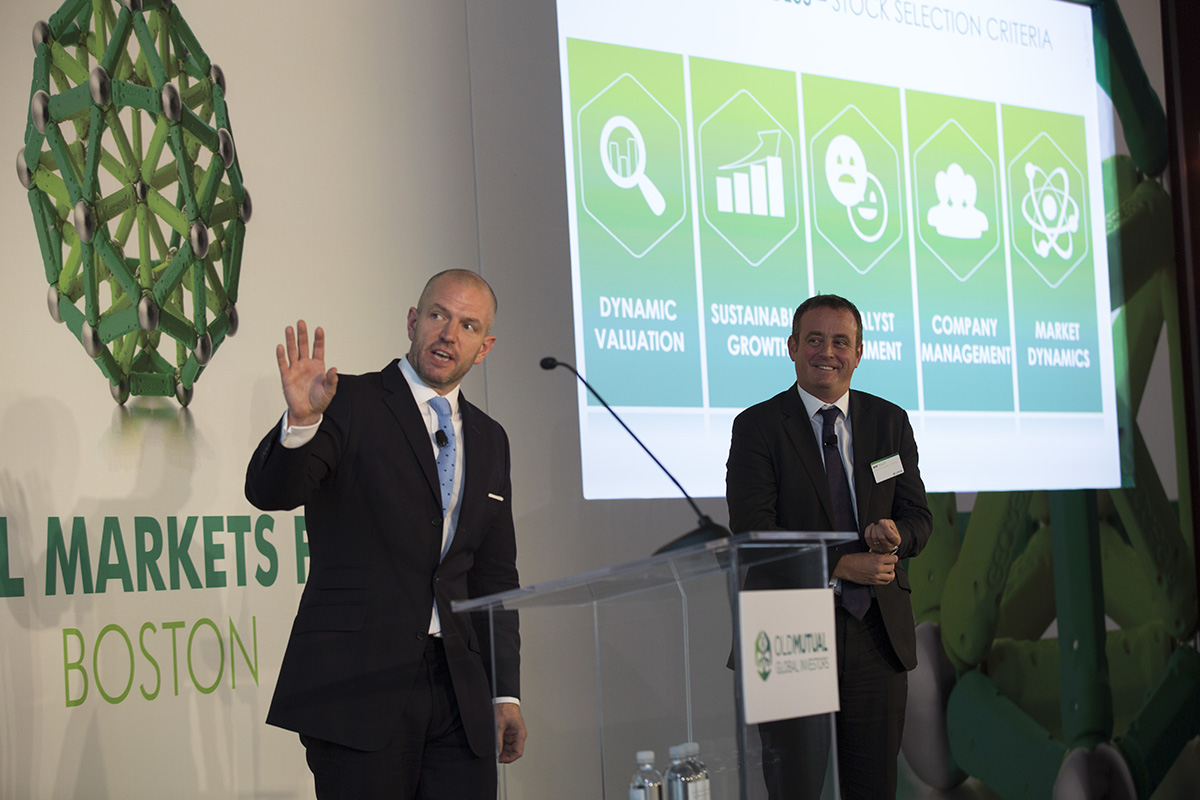During the fourth annual conference of the OMGI Global Markets Forum 2017, Mark Nash, Head of Global Bonds for Old Mutual Global Investors and Lead Manager of the Old Mutual Strategic Absolute Return Bond Fund, explained the implications and risks to financial markets from the gradual withdrawal of monetary stimulus by central banks. Furthermore, he disclosed the bets they are implementing in the portfolio in order to manage the exit of excess liquidity in the markets.
Following the financial crisis, the US Federal Reserve was the first central bank to react by cutting interest rates. The situation was so dramatic that when the traditional instruments failed to take effect, the Fed had to inject liquidity into the economy through several rounds of quantitative easing to get consumers to revive spending.
Almost a decade later, what is the nature of economic recovery? According to Mark Nash, recovery has been slow and somewhat disappointing, with the gradual increase in consumer spending being the main driver. With the recovery, consumers in developed markets, especially the United States, were able to get out of debt.
Fiscal spending soared. Deficits in developed countries skyrocketed as governments were forced to replace consumer demand, with the implementation of austerity measures being particularly counterproductive. Companies have not been especially collaborative, not being especially comfortable with the global scenario; they stopped investing and began to increase recruitment. 2017 has been the year in which investment spending has finally started, the economic cycle is perceived to be long-term sustainable, not overheated, with some improvement in terms of productivity.
But there are two fundamental issues that threaten the cycle: wages and inflation. Globalization and the automation of production processes keep wages down, while the global production gap is widening, technology business models and weak commodity prices helped to depress inflation.
“As regards inflation, what we think is happening is a kind of struggle between the elements that play in favor and those structural elements that play against, such as globalization and the increase of new technological business models, for example, Amazon, Airbnb and Uber, which not only offer new uses of the internet to lower costs, and therefore lower prices, but also attract new supply to the market, helping to keep inflation levels low. In terms of wages, these are down since companies can outsource their employees easily or send their factories to countries where labor is cheaper. Also, the advance of the technology affects wage prices, since many of those jobs will be automated in the future. Unemployment levels have also declined and more people have rejoined the workforce,” Nash said.
What will happen to asset prices once liquidity is withdrawn?
With the injection of liquidity in the markets, financial asset prices have not stopped rising. Bonds boosted their prices as interest rates fell, and shares rose as the only alternative to negative or incredibly low interest rates.
But what will happen to the price once the stimulus is withdrawn? A strong impact is expected, there are clear pressure points: wages and inflation will begin to grow with the withdrawal QE and the increase in interest rates. Furthermore, the current financial conditions are too relaxed, corporate debt continues to grow: “If you lend money to activities that are not being productive, there is a risk that that debt will not be returned to the lender in the end. There is no reason to keep interest rates at the current minimum levels.”
Also, asset prices are high, running the risk of being surprised by a sharp drop when market conditions tighten. Another variable that must be taken into account are the technical factors, the European Central Bank is running out of bonds to buy.
Market consequences and risks
The Bank of England points out that a reduction of stimulus begins to be necessary, the Bank of Canada that the interest rate reduction has already served its purpose, Mario Draghi that the threat of deflation has already been eliminated, and Janet Yellen maintains the rate hike cycle and announced the beginning of the Fed’s balance-sheet reduction.
“Central banks are beginning to undo their positions, bond yields will obviously rise, liquidity in markets will disappear, and markets will start to do their jobs, which is precisely to assign the correct price to assets. Volatility will reappear and passive investment, especially ETFs, which have enjoyed exceptional years due to ‘anything goes’, will fail to yield higher returns than active management. The stock markets and the real estate market will be affected. In addition, assets with lower liquidity such as emerging markets, high yield debt, and REITS will be affected, and may suffer a correction.”
The market may react in a disorderly way, if this happens; adverse conditions that could affect the economic cycle could appear in the market, with economies with the highest debt-to-GDP ratio being the most vulnerable. There is an additional risk in economies such as Australia, Canada, and Singapore, which did not get to deleverage, and whose real estate market may be directly damaged. It is also possible that those mutual funds that have grown disproportionately in recent years may be in a liquidity problem when they are forced to sell and there is not enough liquidity in the market. Finally, the sustainability of the Italian debt may be questioned, raising the risks of the Euro zone.
Looking to the future, as the baby boomer generation and China’s new middle class retires, labor supply will decline, something that should lead to a rise in wages and a decline in global savings. The automation of jobs will help raise productivity above growth levels, supporting the economy. As a result, higher rates are expected, which will be bad for bonds, average for equities and good for inflation and wages. It is expected to be an economic cycle similar to that of the 60s, 70s and 80s.
How to position the portfolio
Finally, Mark Nash explained how to position the portfolio to benefit from the outflow of liquidity in the markets. He recommended a commitment to Long-Short funds and tofavor active management versus passive, to be in the short part of the curve in developed markets, to be short in Italian debt, and to take into account that yield curves will steepen. “Curves have flattened because terms have been eliminated; investors in Japan and Europe buy the long part of the US yield curve, with the withdrawal of liquidity it should steepen.”
Also, he expects an adjustment in the credit markets, which is why he recommends a short position in this asset class because the market ignores the individual credit situation, causing the spreads to be compressed. Regarding currencies, Nash believes the dollar should remain at current levels, but the Euro and other European currencies like Swedish kronor will appreciate. While he recommends avoiding the Swiss franc, which is perceived as an active safe-haven.
Likewise, he recommends buying volatility and protection against inflation, as both should reach the markets naturally once the structural factors are overcome. Investment in emerging markets, as well as high-yield debt, can turn out to be a good bet, both assets have become the means by which to obtain superior returns. When the Fed raises rates again, US bond yields will rise, there will be outflows in these two types of assets, so it would be advisable to exit these asset classes now, and wait for a correction before returning.




 For Fórmate a Fondo
For Fórmate a Fondo